Knitted blouse knitting needles for newborns baby 3 months - this is one of many things that mothers create for their babies. Master classes and tips will help you create original and fashionable things for your child.
Tips for knitting sweaters for newborns
Despite the variety of factory-made children's clothing, nothing compares to the pleasure of knitting booties, a hat, mittens, a blouse for a newborn yourself. All that remains is to choose the right yarn.
The right choice of yarn
Depending on the season, yarn for knitting a children's sweater can be different: from cotton to wool.Manufacturers of knitting threads produce separate lines with the prefix "baby". This means that the yarn is maximally adapted for delicate baby skin, does not pill or itch.
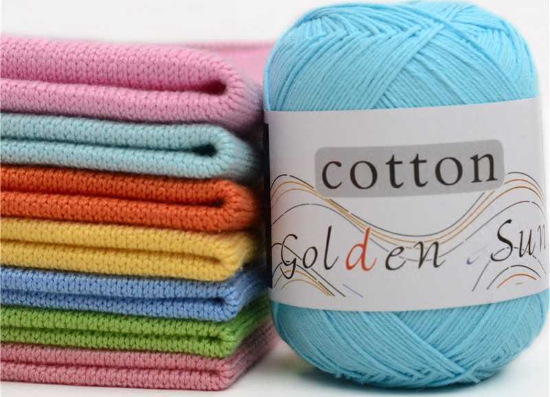
Yarn for children's products comes in the following types:
- natural wool (angora, merino, rabbit, goat);
- mixed (a mixture of wool and synthetic fibers in different proportions);
- natural cotton, viscose, silk;
- a mixture of cotton, viscose or silk with artificial threads;
- synthetic (acrylic, polyester, nylon, polyamide).
Based on the selection presented, you need to determine whether this or that yarn will be comfortable for the baby.
What to look for when choosing:
- Dye fastness. In the store, you can check the dyeing by squeezing and pulling the thread through a white damp cloth. The shedding material will definitely leave a mark. Such yarn can cause irritation of delicate skin and provoke an allergy.
- Softness. By placing the skein on the inside of the forearm, closer to the elbow, you can understand how coarse the thread is. When in contact with the skin, a prickly blouse will bother the baby, preventing him from learning about the world around him.

- Heat and air conductivity. These qualities affect the child's heat exchange. An important characteristic of materials for children's products is heat retention and air circulation. The baby will not be hot in such products.
- Wear resistance. Some of the wool threads quickly roll up, making the product look unpresentable. In addition, the pellets can accidentally get into the baby's mouth, which is unsafe.
- Hypoallergenic. Both unstable dyes and wool fibers can cause allergies. Unfortunately, it is impossible to check this in the store. But if the skin of a newborn is very sensitive, it is better to give preference to natural cotton, silk or synthetic threads.
Simplicity of style
A blouse for a newborn (with knitting needles) 3 months can have a very simple style. There is no need to make armholes, necklines, knit complex sleeves and collars. Any mother can knit a cute blouse from just 2 skeins of yarn.
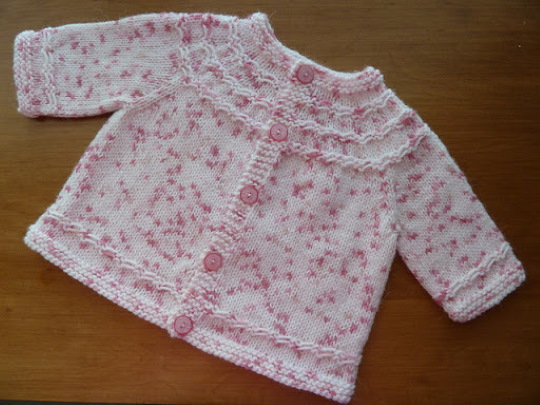
Little blouses come in the following styles:
- on a round yoke;
- with raglan sleeve;
- with a simple sleeve.
The options with a yoke and raglan "grow" with the baby. It is enough to only knit the sleeves and the length of the product. With straight-cut sleeves, the clothes will also last a long time, since the baby does not grow so quickly during the first year.
Fashionable mothers want their baby to be dressed in the spirit of the times, and therefore sometimes choose models that are not suitable for infancy. During this period, it is better to give preference to color combinations and brightness of clothes than to sacrifice comfort.
Excessive decorative details, rough zippers, hooks and buttons should be present in minimal quantities on children's clothing. The blouse should be of a size that does not restrict the child's movements. Tight models made of thick, coarsely knitted yarn will cause discomfort and limit freedom of movement.
Types of children's blouses:
- sweaters;
- cardigans;
- jackets;
- blouses with buttons;
- blouses with ties;
- hooded sweatshirts.
Features of seams
During infancy, a child spends most of the time lying down, so the seams on children's products are made soft and almost invisible. Often knitted items for newborns are made seamless. In this case, a win-win option is a raglan blouse.
Knitting density and pattern
A blouse for a newborn (with knitting needles) 3 months should be knitted according to the principle "the simpler, the better". This means: comfortable for the baby and comfortable for the mother.
The density of the knitting and the pattern depend on the season. For the summer, you can knit an openwork thing with a light knitting from thinner threads. In winter, a warm sweater made of soft, bulky yarn will keep your baby warm.
How to prepare and start knitting:
- Determine the baby's size by taking the necessary measurements.
- Choose a suitable model of blouse.
- Decide on the yarn and purchase the required amount indicated in the master class.
- Read the yarn label to find out what size needles or hook you need.
- Select suitable knitting tools. At the same time, prepare scissors, knitting pins, and auxiliary knitting needles.
- Start knitting according to the instructions.
If the yarn label does not indicate the needle number, then for medium-thick yarn you can take number 3 or 3.5. The same sizes are suitable for the hook.

To determine the number of loops needed, you need to knit a 10 x 10 cm sample and count how many loops are in 1 cm. Multiply the resulting number of loops by the width of the piece and get the number of loops needed to cast on.
Dimensions
To find out the baby's size, take 3 main measurements: chest circumference, sleeve length, and garment length. Based on the chest circumference, you can determine the width of the back and the width of the shelf. The width of the back is equal to the chest circumference divided by 2. The shelf size is determined by dividing the chest circumference by 4.
If a magazine or master class specifies a clothing size, you can use the following table to choose the correct one.
| Age | Height | Chest circumference | Weight | Size |
| 0 - 1 month | 50-55 cm | 36 cm | 3 – 3.5 kg | 50 - 56 |
| 2 – 3 months. | 58-62 cm | 40 cm | 5 – 5.5 kg | 56 - 62 |
| 3 – 6 months. | 63-68 cm | 44 cm | 7 – 8 kg | 62 - 68 |
| 6 – 9 months. | 69-74 cm | 48 cm | 8 – 9 kg | 68 - 74 |
| 9 – 12 months. | 75-80 cm | 52 cm | 9 – 11 kg | 74 - 80 |
Blouses for newborns from 0 to 6 months, crocheted or knitted, are usually made with cuffs on the sleeves. When the child grows quickly, this reserve is unfolded and the item continues to be used. Cuffs do not spoil the appearance of the product. If they unfold arbitrarily, they can be temporarily sewn to the sleeve as a cuff.
Knitting patterns for blouses for newborns and their description for beginners
Baby clothes are very small and easy to crochet or knit. The level of complexity of such items is below average. Even a mother who is a beginner in knitting will be able to create a blouse for her baby if she chooses a simple knitting pattern.
To make simple knitting more attractive, use color combinations in the form of stripes or gradients. To do this, you only need to change the thread. You can also alternate simple patterns: for example, the front surface with garter stitch or "tangle".
Seamless clothing
Master class on knitting a simple striped blouse is designed for a newborn up to 3 months. The model has shelves and a button fastening.

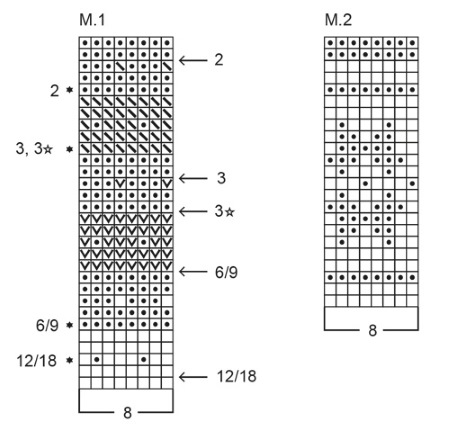
For knitting you will need:
- circular knitting needles;
- yarn.
Progress of work:
- Cast on 40 stitches and knit a 1 x 1 rib pattern, 2 cm in size, with white thread.
- Next, the raglan will be knitted and loops will be added. To do this, mentally distribute the loops so as not to get confused. Shelves - 5 loops each, back - 12 loops, sleeves - 5 loops each and raglans (loops on 2 sides of the sleeve) - 2 loops each.
- Knit 5 rows in red according to the following pattern: on the front side, make a yarn over before and after each raglan, on the back side, knit without yarn overs.
- Repeat knitting with white, continuing to make yarn overs each time.
- Knit 7 alternating stripes (not including the collar elastic). Total 35 rows.
- Loops for the sleeves, all that are obtained between the raglan diagonals, are lowered onto an auxiliary thread.
- Continue knitting in 2 directions the loops of the front and back. Make a total of 6 alternating color stripes of 5 rows (30 rows in total).
- Knit the last 5 rows with a 1 x 1 elastic band. Close the loops.
- Knit the sleeve loops in a circle and make 30 rows.
- Transfer the stitches to thinner needles. This will make the cuff more elastic. Knit a 5-row elastic band using the 1 by 1 pattern. Close the knitting.
- Cast on a number of loops along the edge loops of the shelves equal to the number of rows and knit strips of 3 cm each. On one side, using yarn overs, make holes for buttons.
A little tip: for knitting elastic bands, it is better to use knitting needles with a smaller diameter. The elastic band will be denser and more elastic.
Raglan
According to the pattern above, you can knit absolutely any models for babies. To knit a blouse of the required size, it is recommended to measure the neck and calculate the number of loops. To do this, measure the baby's neck, knit a sample and count the number of loops in 1 cm.
Options for raglan blouses for boys:
- A dark grey or blue sweater with voluminous braid patterns and double elastic on the collar.
- Olive green cardigan with hood and button fastening, made with garter stitch.
- A pullover with diamonds and a pearl knit base, made in khaki with contrasting elastic bands on the collar, cuffs and hem.
- White raglan pullover, knitted according to the pattern 5 front loops to 5 back loops without shaping the neckline and cuffs.
- Nautical style sweater with pockets and applique.
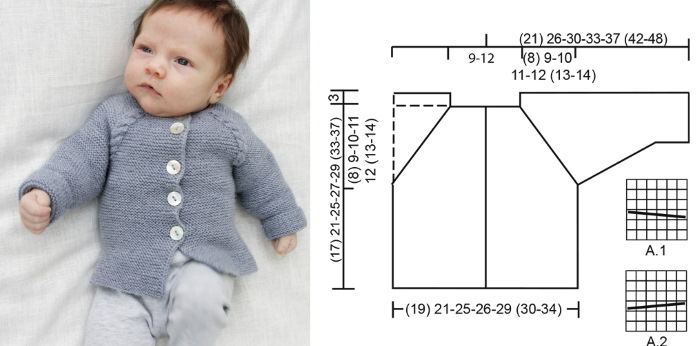
Models for girls:
- Openwork summer blouse with short sleeves in a light color and ties.
- Warm cardigan with pockets and lining in dusty pink color, with a hood, made with garter stitch.
- White sweater with numerous voluminous braids, a turtleneck collar and double-folded cuffs.
- A bright striped blouse with a large button fastening.
- Blue jacket with openwork inserts and a hood with a tassel at the end.
Model with a hood
The model for a little fashionista looks warm and cozy, made of fleecy yarn with a zipper and a kangaroo pocket. For work you will need knitting needles No. 3 and mixed elastic yarn with fleecy yarn.
Knitting for size 62-68:
- To knit the back, cast on 44 stitches and knit the bottom strip 2.5 cm in garter stitch. Then continue with the front surface, in each 12th row decrease 1 stitch three times.
- After 19 cm for the armhole decrease: 2 loops and in each 2nd row twice 1 loop.
- After 28 cm, close the middle 6 loops for the neck and knit each shoulder separately. In each 2nd row in the neck, decrease 2 loops twice and 1 loop once. Close all loops after 32 cm from the strip.
- Knit the shelves as follows: cast on 23 stitches and knit a 2.5 cm strip with garter stitch. In each 12th row, decrease 1 stitch three times.
- After 19 cm, decrease 2 loops and in every 2nd row, decrease 1 loop twice.
- After 31 cm, close the middle 9 loops and then in the 2nd row, close 3 more loops. After 32 cm, close the loops.
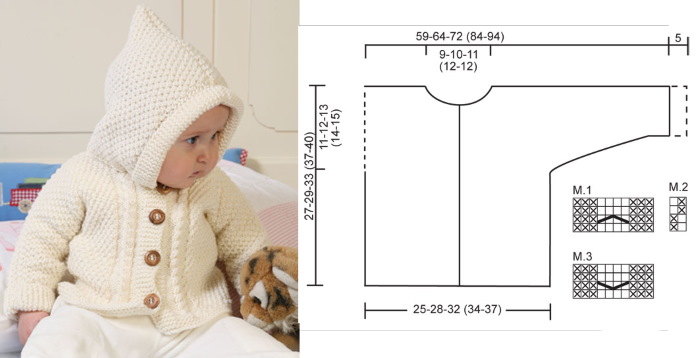
- Knit both shelves symmetrically.
- Sleeves: cast on 30 stitches and knit with stockinette stitch. In every 12th row add 1 stitch 2 times along the edges.
- After 14 cm from the beginning, decrease 3 loops twice on each side. After 19 cm from the beginning of knitting, close all loops.
- For the hood, cast on 60 stitches and knit 2.5 cm in garter stitch. Then knit in stocking stitch as follows: after 13 cm from the strip, in every 2 rows, close 5 stitches on 2 sides 4 times and 4 stitches on 2 times. After 18 cm from the strip, close all stitches.
- For the pocket, cast on 20 stitches and knit with the front surface. In every 8th row, decrease 1 stitch. After 9 cm, close the knitting.
- Assemble the blouse: sew in the sleeves, zipper, sew on the pocket. Make a tassel from the same yarn and sew it onto the hood.
Round neck pullover
For summer walks, a baby blouse with a round yoke and short sleeves will be an irreplaceable thing. You can choose any color for knitting. Threads are preferably cotton or viscose, medium thickness.
You will need:
- Yarn - 100 g;
- Circular knitting needles No. 3.5 mm.
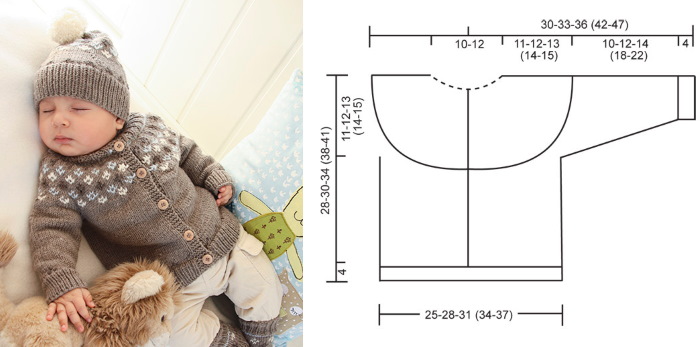
Knitting progress for a 3 month model:
- Knit the front and back in one piece without seams. Cast on 126 stitches and knit 6 rows with a “small rice” pattern, alternating 1 purl and 1 front stitch.
- Knitting can be done with an openwork pattern or with a simple garter stitch pattern. Knit 17 cm.
- Distribute the loops: 32 loops - right side panel, close 3 loops for the armhole, 57 loops - back panel, close 3 loops for the armhole, 32 loops - left side panel.
- Knit the fronts as follows: for the armholes, decrease 1 loop three times in every 2nd row. Stop knitting the fronts.
- On the back, knit 6 rows, decreasing 1 stitch three times on each side for the armholes. Put the knitting aside and knit the sleeves.
- Sleeves can be knitted to any length. For a long sleeve, cast on 38 stitches, knit 2 rows in garter stitch, evenly adding 10 stitches in the last row.
- After 15 cm, close 1 loop three times in every 2nd row. Do not close the knitting.
- Yoke: remove stitches from the auxiliary knitting needles in the following order: 29 – right front, 41 stitches – right sleeve, 51 stitches – back, 41 stitches – left sleeve, 29 – left front. Knitting pattern – garter stitch.
- In row 1, make a reduction according to the pattern: knit 4 front loops and 2 simultaneously 1 front loop. Repeat to the end of the row, without reducing in the strip loops.
- In the 3rd row, make a decrease by knitting 3 front loops, 2 together front loops, 1 yarn over. Knit to the end of the row. Then thread a satin ribbon through the resulting holes.
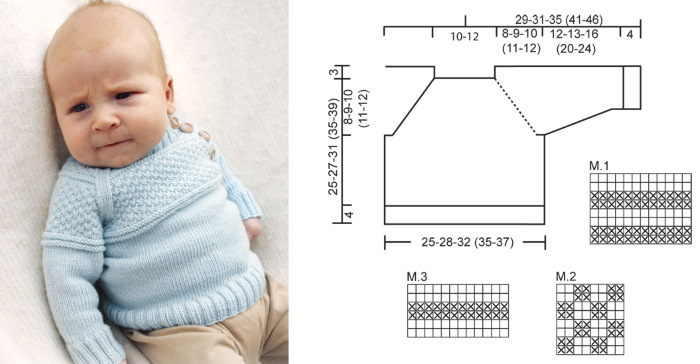
- In every 6th row, reduce the loops, just like in the 1st row of the yoke. Knit 31 rows.
- In row 32, knit 2 knit stitches, 2 together knit stitches and 1 yarn over in sequence. Repeat to the end of the row.
- Close all loops.
- Assemble the product, sew on buttons and make a edging by crocheting the edges with single crochet stitches. Thread a satin ribbon into the yoke.
Clothes with buttons
The button-down model can be crocheted and knitted using a simple pattern, which consists of rectangular pieces for the front, back and sleeves.
A blouse for a newborn (with knitting needles) 3 months is knitted according to the pattern:
- Make patterns for the front, back and sleeve. To do this, measure the baby's chest circumference, the desired length of the blouse and sleeve. Construct rectangular pieces according to the dimensions. The pattern can be made using any other item of the child's clothing.
- Average dimensions of the pieces: back - 26 cm by 28 cm, front - 13 cm by 28 cm, sleeve top width - 26 cm, bottom - 14 cm, sleeve length - 17 cm. Leave 13 cm for the armhole, 10 cm for the neckline.
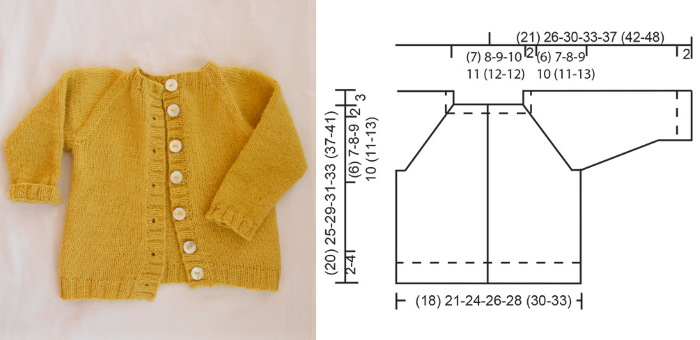
- Crochet or knit a sample and calculate the number of loops.
- Knit each piece separately. Sleeves can be narrowed by reducing stitches.
- On the front edges of the shelf, knit the strips. On one strip, make loops for buttons.
- Knit cuffs on the sleeves and sew the longitudinal seams of the sleeves.
- Sew the side and shoulder seams without sewing the loops for the neck. Bind the neck, making a collar.
Model with ties
Popular models of knitted sweaters with ties for babies:
- openwork summer cape with ties on the collar;
- a model with an imitation yoke, expanding towards the bottom and tying at the waist level;
- A wrap-around jacket with ties.
For the model of a summer blouse with ties for a 3-month-old girl you will need:
- cotton, viscose or linen yarn. Threads with the addition of synthetic elastic fibers can be used;
- hook No. 3;
- openwork pattern diagram.
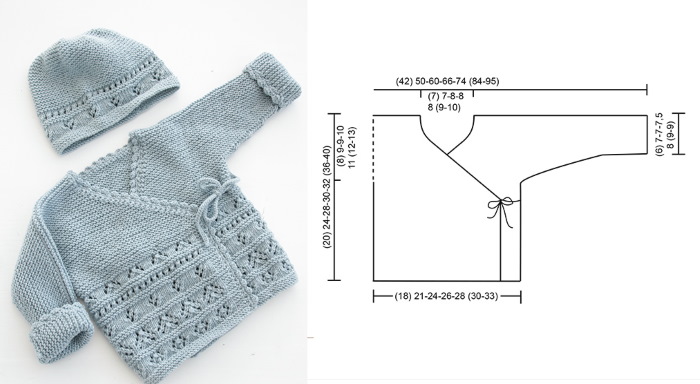
Knitting order:
- Create a life-size pattern by measuring the baby's dimensions. You can take the dimensions of the parts indicated in the previous master class on knitting clothes with buttons.
- Knit a sample and calculate the number of stitches needed to cast on.
- The back and other parts are knitted as follows: cast on the required number of stitches, knit 10 cm and attach to the pattern. If the dimensions match, continue knitting.
- Make a neckline on the shelves and back. The neckline on the shelves should be a little deeper. Having knitted 25 cm, evenly decrease from the center side 1 time 3 loops, 1 time 2 loops and 2 times 1 loop. Start closing the back neckline, having knitted 27 cm from the beginning. Decrease the middle 10 loops and then in the second row another 2 on each side.
- Start knitting the sleeves from the top edge, decreasing the stitches evenly and trying them on to the pattern.
- Sew the pieces together or connect them with a crochet hook. Trim the edges with a "crayfish step" trim. Sew satin ribbons on top of the shelves.
Option with smell
A knitted baby romper, vest or fashionable cardigan with a row of large buttons on the side - knitted according to the wrap-over sweater pattern.
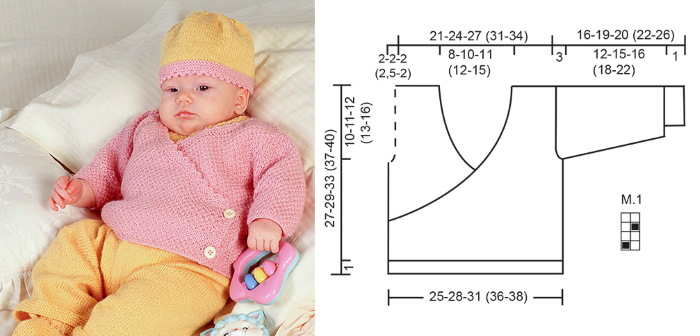
This item can be knitted in the following ways:
- without side seams on circular needles;
- a model made from separate parts of the back and front, knitted with needles;
- crocheted blouse without side seams;
- a crocheted jacket with external seams.
The blouse for a newborn (with knitting needles) 3 months is designed for standard sizes. If the baby is larger, it is recommended to take measurements. To knit a fluffy striped wrap-around tie-on baby romper, you will need yarn and knitting needles of the appropriate size. If the fluffy yarn is very thin, it is recommended to take a duplicate thread of the same color.
The master class uses the “stripes” pattern, which is knitted as follows: 2 rows of garter stitch in color 1, 2 rows of stockinette stitch in color 2, 2 rows of garter stitch in color 1, 4 rows of stockinette stitch in color 2.

Knitting progress:
- Back: cast on 72 stitches, knit 4 rows of stockinette stitch for the turn-down and then continue with the stripe pattern. After knitting 29 cm, close the stitches.
- Left side panel: cast on 36 stitches, make a turn-up of 4 rows of stocking stitch. Knit using the "stripes" pattern. Having reached 16 cm, begin decreasing for the neckline bevel. In every second row, decrease 3 stitches, knitting them with the front stitch. At a height of 29 cm, close the shoulder stitches (18 pcs.).
- The right shelf is knitted according to the pattern of the left shelf, in mirror image.
- Sleeves: cast on 62 stitches, knit a 4-row cuff in stocking stitch. Knit with a stripe pattern and close all stitches at a height of 18 cm.
- Sew the blouse, leaving a gap for the tie in the right side seam. Sew the long tie to the corner of the left side panel, and the short one to the right.
Square Neck Print Blouse
The main emphasis of the product is the design. To make this model, you can take a knitting pattern from any master class and select an embroidery pattern for the loops. This option is convenient because it eliminates the need to knit patterns with colored threads. At the same time, the pattern is just as high-quality.
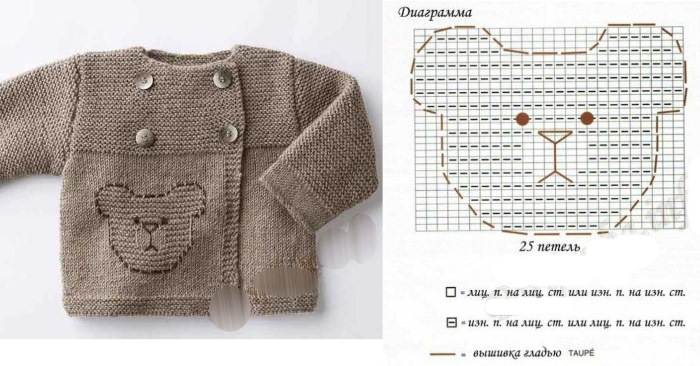
To knit a square neck, the loops are closed simultaneously in one row. Such a neck can be decorated with a braid or tied with a decorative border. Often, in such a model, the sleeves are not narrowed, but made with a large lapel.
Model with applique
A wide range of ready-made appliques will allow any mother to make her baby's clothes unique. Appliques can be placed on pockets, on the back or on the shelves. This depends on the size of the selected element and the number of appliques.
Appliques on baby clothes should be sewn on securely so that the baby does not tear them off or put them in his mouth.You can make the patch decoration yourself using pieces of fabric or crochet the decoration.
Knitting and crocheting bring pleasure to a young mother from creating cozy things for her newborn baby, and also helps to relax and unwind. You can knit a blouse for a 3-month-old baby using the patterns provided in this article.
Video about knitting for newborns
Knitted blouse for a newborn baby 3 months:

Great article! Found some very interesting ideas for myself